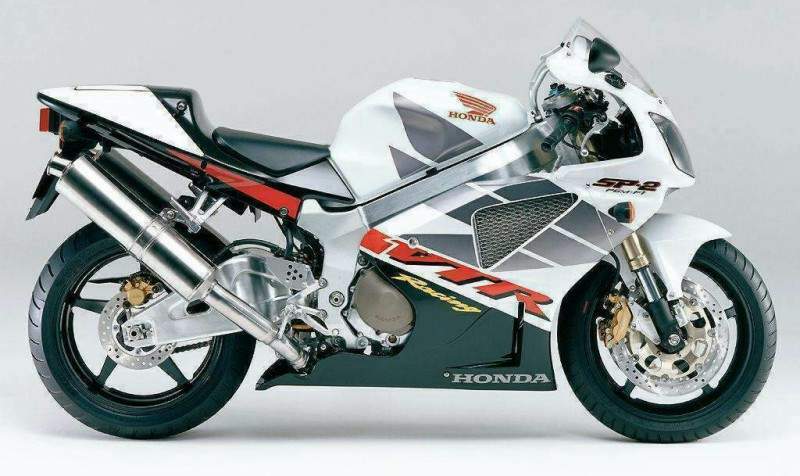
|
|
|
|
|
|
Classic Bikes
Custom Bikes
Individual
Racing Bikes AJP
AJS
Aprilia
Ariel
Avinton / Wakan
Bajaj
Benelli
Beta
Bimota
BMW
Brough Superior
BRP Cam-Am
BSA
Buell / EBR
Bultaco
Cagiva
Campagna
CCM
CF Moto
Combat Motors
Derbi
Deus
Ducati
Excelsior
GASGAS
Ghezzi Brian
Gilera
GIMA
Harley Davidson
Hero
Highland
Honda
Horex
Husaberg
Husqvarna
Hyosung
Indian
Jawa
Kawasaki
KTM
KYMCO
Laverda
Lazareth
Magni
Maico
Mash
Matchless
Mondial
Moto Guzzi
Moto Morini
MV Agusta
MZ / MuZ
NCR
Norton
NSU
Paton
Peugeot
Piaggio
Revival Cycles
Roland Sands
Royal Enfield
Sachs
Sherco
Sunbeam
Suzuki
SWM
SYM
Triumph
TVS
Ural
Velocette
Vespa
Victory
Vincent
VOR
Voxan
Vyrus
Walt Siegl
Walz
Wrenchmonkees
Wunderlich
XTR / Radical
Yamaha
Zero
Video
Technical
Complete Manufacturer List
|
Honda VTR 1000 RC51 SP2
The RC51 was designed as the motorcycle to be used by Honda's racing
teams in the Superbike World Championship.The 2000–2001 models are
designated SP1, while the 2002–2006 models are designated SP2 (the latter
having updated fuel injection and suspension systems). Honda was unable to win consistently, particularly because of rival V-twins' displacement advantage over Honda's V-4. In 2000 Honda released the RC51, powered by a 999 cc liquid-cooled V-twin engine. That year, it won the World Superbike Championship with Colin Edwards riding for the Castrol team. In 2001, Ducati regained the title but the RC51 was still a contender boasting superior reliability with comparable speed and power. The RC51 won again in its final year of factory-supported racing in World Superbike in 2002 after Edwards' tremendous title fight with Troy Bayliss and that same year also captured the AMA Superbike title with Nicky Hayden. Honda had taken the lessons learned in the SP-1's first season, producing the SP-2 for 2002. A stronger, more rigid frame and swingarm were identical to the WSB race bike parts and engine modifications boosted peak power by 3 kW (4 bhp) and cut weight by 5 kg (11 lb). Factory specifications for road going SP-2s (sourced from Honda) were
133 bhp with a top speed of 168 mph. 2003–present Honda stopped official support for superbike racing in 2003 (though some teams have had factory support) and as superbike rules changed to allow 1000 cc 4-cylinder bikes the RC51 was replaced by the CBR1000RR Fireblade as the Honda superbike racer. In 2004, Honda released the Nicky Hayden special edition, which differed from previous models in that it had a brushed aluminum frame and swing arm, a sticker kit, and white number plates on the front upper fairing and tail fairing.
New for 2002
Engine/Drivetrain
 SUSPENSION
Additional Features
Honda's RC51 won the 2002 AMA Superbike championship as well as dethroning
Ducati as World Superbike champion. The 2003 RC51 offers incredible
superbike performance for enthusiasts seeking the most powerful, best
handling V-twin sport bike.
Engine/Drivetrain
· Nutless connecting rods feature bolts threaded directly into tapped holes
in rods. Design is lighter than conventional bolt-and-nut combination.
Carburized rods provide strength and durability under high loads.
SUSPENSION Additional Features
Review
Whatever the multimillion-dollar factory riders want, it
seems they get. And if any of those changes happen to benefit street riders,
well fine--but it's almost an accident. So it is for 2002: A multitude of tweaks
have arrived to make the '02 RC51 more competitive on the track, but the
trickle-down effect is that the bike is now much improved for puck-wearing
plebes.
Even though the steering-head angle has been reduced one degree to 23.5
degrees--the steepest of any Honda--the RC51 feels planted at all speeds, even
at 130 mph through Willow Springs' infamous Turn Eight. There you sit, tucked
behind the splendid new windscreen that's 1.2 inches taller than last year's,
sensing no instability from either end of the bike. Of course, the new swingarm
(890 grams lighter) is 16mm longer and aids the stabilization effort. Source Motorcyclist
|
|
|
Any corrections or more information on these motorcycles will be kindly appreciated. |